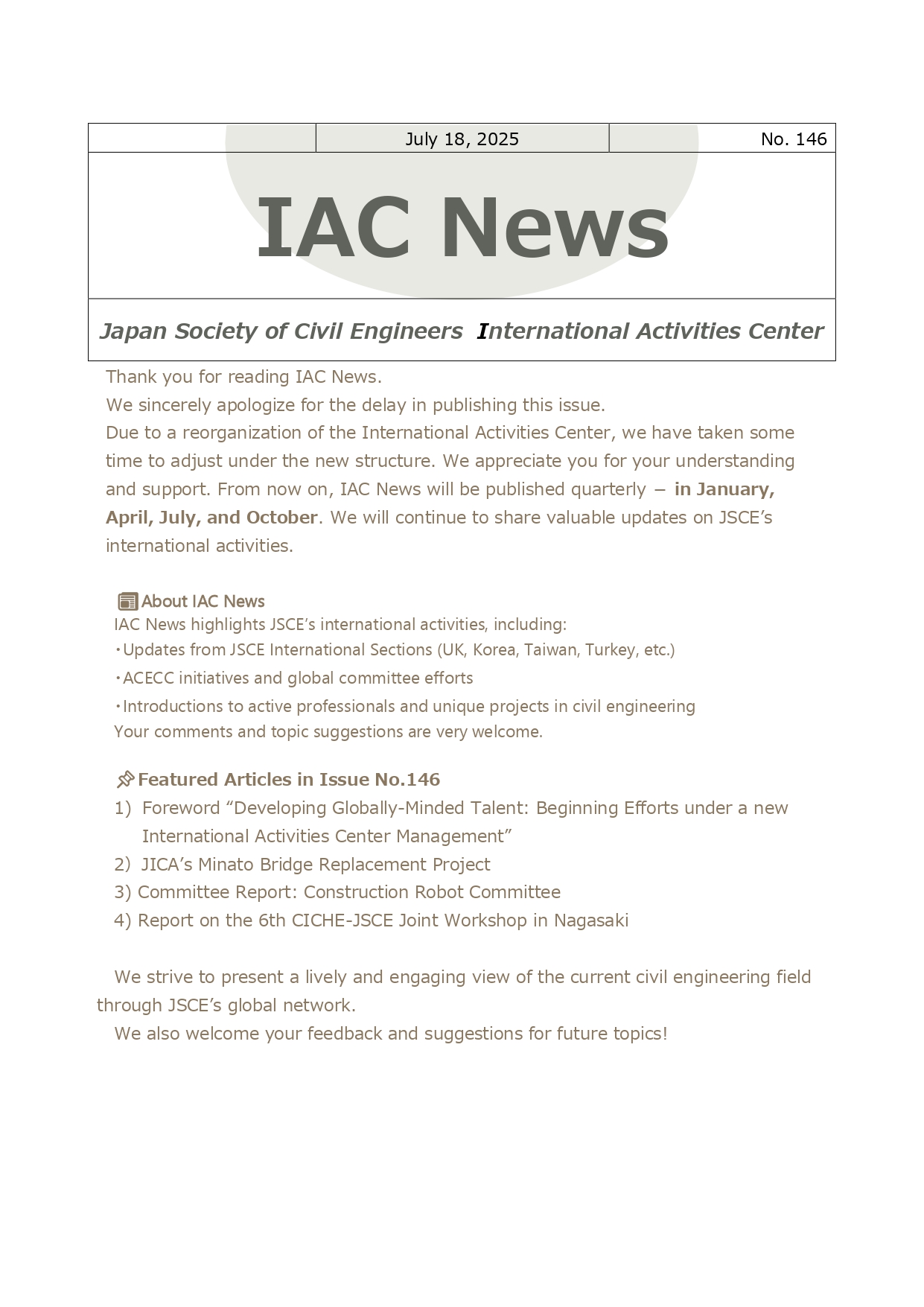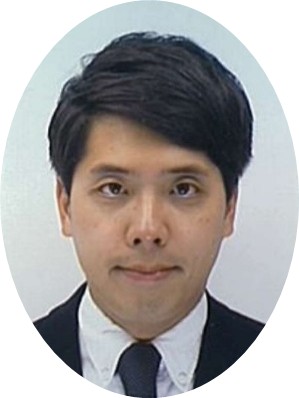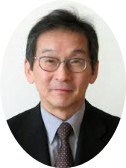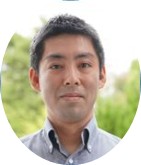IAC News
IAC News No.146, July 2025
Japan Society of Civil Engineers International Activities Center July 18, 2025 IAC News No.146
Thank you for reading IAC News.
We sincerely apologize for the delay in publishing this issue.
Due to a reorganization of the International Activities Center, we have taken some time to adjust under the new structure. We appreciate you for your understanding and support. From now on, IAC News will be published quarterly - in January, April, July, and October. We will continue to share valuable updates on JSCE’s international activities.
📰About IAC News
IAC News highlights JSCE’s international activities, including:
・Updates from JSCE International Sections (UK, Korea, Taiwan, Turkey, etc.)
・ACECC initiatives and global committee efforts
・Introductions to active professionals and unique projects in civil engineering
Your comments and topic suggestions are very welcome.
📌Featured Articles in Issue No.146
- Foreword “Developing Globally-Minded Talent: Beginning Efforts under a new International Activities Center Management”
- JICA’s Minato Bridge Replacement Project
- Committee Report: Construction Robot Committee
- Report on the 6th CICHE-JSCE Joint Workshop in Nagasaki
We strive to present a lively and engaging view of the current civil engineering field through JSCE’s global network.
We also welcome your feedback and suggestions for future topics!
Foreword
Developing a Globally-Minded Talent: Beginning Efforts under a New International Activities Center Management
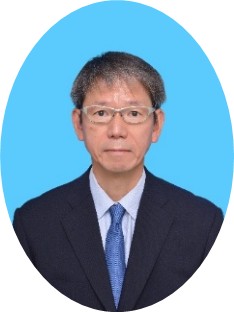
Makio Shichijo,
IAC Acting Director
(Sato Kogyo Co., Ltd.)
The International Activities Center (IAC) was established in April 2012 as an organization with functions across the organizations within JSCE, including the survey and research committees.
Since then, the IAC has undertaken
a variety of different activities, such as exchanges with overseas partner societies, company workshops for international students, and technical seminars. The IAC’s activities have been diverse over the last 10 years. However, with initiatives often carried out separately, there has been little organic coordination between them. It seems as though our activities over the last few years have been praised for achieving certain goals.
On the other hand, however, looking at the civil engineering industry, the number of large-scale domestic projects, which are essential for passing on skills, is declining. Furthermore, Japan’s techno-logical superiority over other countries is also declining somewhat. There also seems to be a situation where the young generation, including researchers, is less involved internationally. With these changes to the social environment that civil engineering finds itself in, we undertook discussions on what to expect from the JSCE IAC and how past activities should be organized and built upon.
The result of these discussions was recognizing the importance of globally- minded talent, including promising personnel. JSCE, based on the awareness that “as a collaboration of industry, government, and academia, we foster the development of personnel through practical, on-site training with the support and cooperation of our members,” we have redefined the mission of the IAC to a new mission of “Striving to develop internationally minded individuals”.
To date, the International Activities Center has undertaken activities under the following six groups: the Information Group, International Communication and Cooperation Group, Education Group, Project Group, International Students Network Group and International Civil Engineers Group. However, to achieve our new mission, a drastic review was carried out of our activities. Reshuffling the original groups into the four groups of (1) Planning and Strategy Group, (2) International Communication and Collaboration Group, (3) Globally Minded Talent Development and Project Group, and (4) International Students and Civil Engineers Group, we will start activities under a new management this fiscal year.
While the plan for activities of each group will be fleshed out further going forward, for the time being, the activities are thought to be as follows:
(1) Planning and Strategy Group
Formulates and proposes plans and strategies for the activities of the International Activities Center and plans the effective collecting and sharing of information.
(2) International Communication and Collaboration Group
• This group will promote networking activities between senior civil engineers and up-and-coming civil engineers. In addition to Taiwan, with which we are currently engaged in active exchanges involving young civil engineers, this group will promote international exchange with promising civil engineers in multiple countries, including developed ones. In fiscal 2025, this group will aim to further network with Indonesia and the UK.
• This group will collaborate with outside organizations like civil engineering non-profit organizations and nongovernmental organizations, and support/promote the international cooperation efforts of civil engineers.
(3) Globally-Minded Talent Development and Project Group
• This group will provide technical assistance in international projects. Forming a unit of civil engineers and researchers, young and old, this group will facilitate the handing down of skills.
• This group will also plan seminars concerning international projects, aiming to encourage young civil engineers to get involved in international activities.
(4) International Students and Civil Engineers Group
• This group will help form a network of international students, civil engineers and researchers working in Japan, and provide opportunities for workshops, discussions, countermeasure examination, and networking.
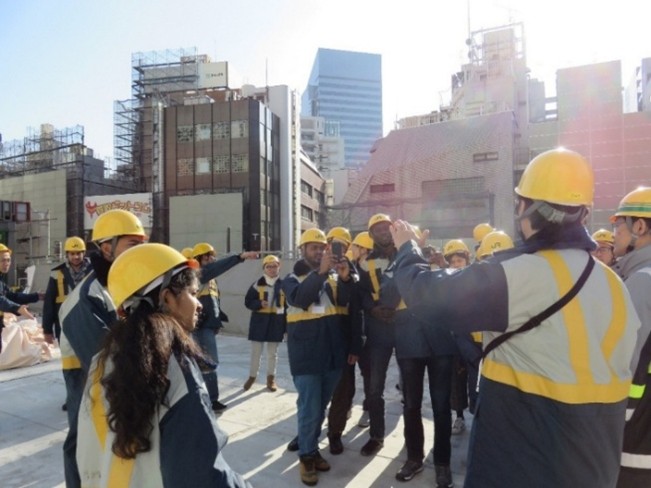
I sincerely hope that all our members will provide even more support and cooperation toward these new activities of the International Activities Center.
・・・・・・・・・・・・・・・・・・・・・・・・・・・・・・・・・・・・
Report by Makio Shichijo, IAC Acting Director
(Sato Kogyo Co., Ltd.)
・・・・・・・・・・・・・・・・・・・・・・・・・・・・・・・・・・・・
JICA’s Minato Bridge Replacement Project
Kazuki Yamada,
(Japan International Cooperation Agency)
The Japan International Cooperation Agency (JICA) carries out cooperative projects through various schemes such as technical cooperation, ODA loan assistance, and grant aid assistance for developing countries. This report introduces the Minato Bridge Replacement Project (hereinafter “the project”) undertaken as a grant aid project in the Republic of Palau (hereinafter “Palau”).
Are you familiar with the country Palau? Perhaps many of you picture tropical resorts and beaches when you hear the name Palau. In fact, Palau also has a JICA office, which engages in various collaborative projects for maintaining social infrastructure.
Palau is an island nation located in the Pacific Ocean and has a population of approximately 18,000 people. Palau is made up of over 300 islands. As the main places where people live, there is Melekeok, which is the capital, Babeldaob Island, which is home to an international airport, Malakal Island, which has Palau’s only commercial port, and Koror Island, which is where about 70% of the country’s population live. A feature of Palau is that its people go back and forth between the islands as part of their day-to-day lives. Because the main mode of transport on the islands is cars, the bridges that connect the islands are a truly essential piece of infrastructure. There are about nine bridges in Palau. The largest bridge is the 413-meter-long Extradosed Bridge, which connects Babeldaob Island and Koror Island. The bridge was built in 2002 with the help of JICA and is well-known for its name coined after the good relations between Japan and Palau.
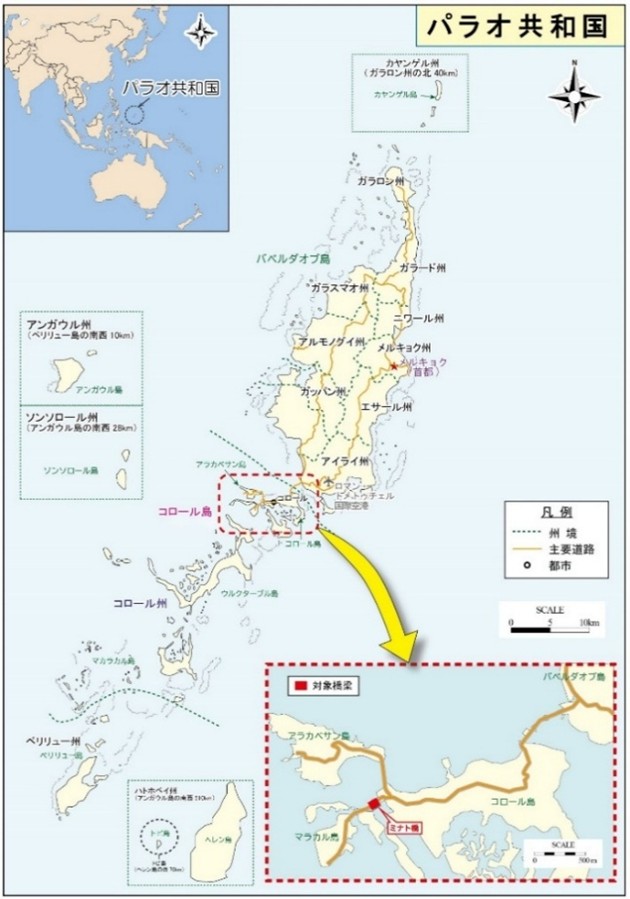
The Minato Bridge, which was the subject of this project, is located on the Malakal Courseway, which connects Malakal Island and Koror Island. The bridge was built in 1927 by the Nan’yo Cho (Territorial Government of The South Seas). Although the bridge was destroyed temporarily during World War II, funds from the US government saw it rebuilt in 1979. Later on, while repairs such as rust removal, anti-corrosion work, and crack repairs associated with deterioration over time were conducted, saltwater corrosion has caused significant degradation of the concrete. The Minato Bridge is the only bridge that connects Malakal Island and Koror Island and it holds critical infrastructure such as power lines, communication lines, and water and sewer systems. Therefore, if the bridge were to collapse, it would have a severe impact on economic and social activities in Palau. This is why the government of Palau asked for assistance in replacing the bridge and how the project came about。
With the help of CTI Engineering International Co., Ltd., foundational surveys such as land surveying and boring investigations have been conducted for project implementation since 2023, and detailed design work is currently in progress. If the project continues on schedule, the construction work will be completed and the bridge opened around 2027.
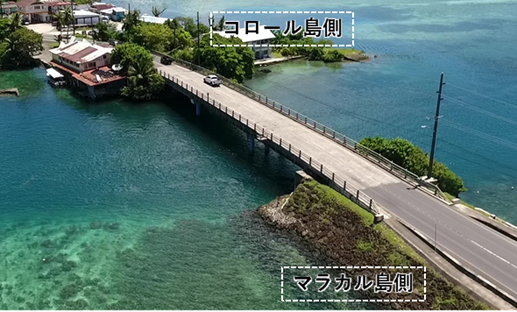
Current Minato Bridge state
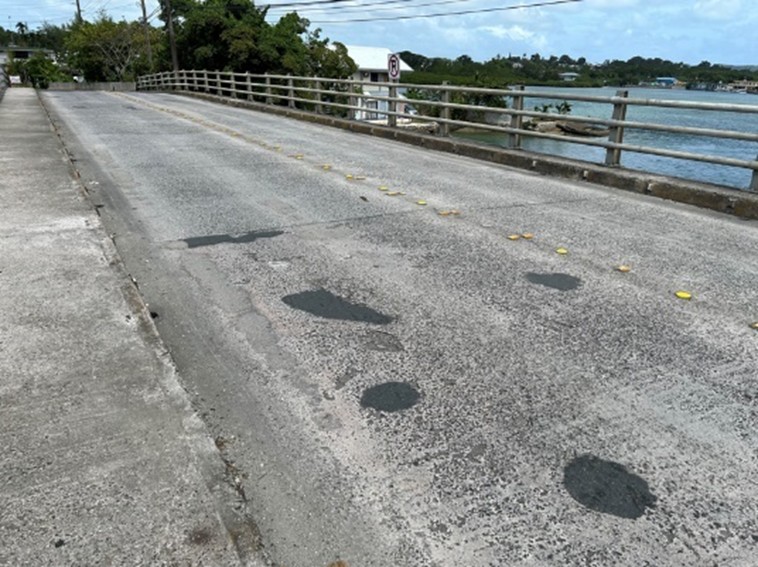
Current Minato Bridge state
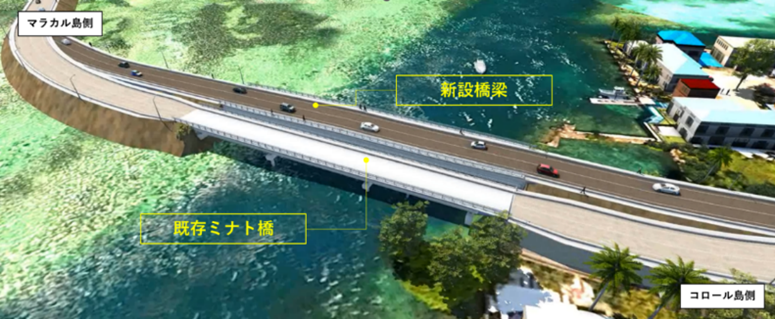
Figure illustrating what the Minato Bridge will look like when it’s complete
Having witnessed, through this project, the roads and bridges on this island nation functioning as truly essential infrastructure, it has reminded me of the importance of maintaining and looking after social infrastructure. JICA will continue to support the road infrastructure sector in developing countries. I hope that the young engineers out there also take an interest in overseas projects, which offer something different from those in Japan. Thank you all for your continuous support and cooperation.
・・・・・・・・・・・・・・・・・・・・・・・・・・・・・・・・・・・・・・・・・
Reported by Kazuki Yamada
(Japan International Cooperation Agency)
・・・・・・・・・・・・・・・・・・・・・・・・・・・・・・・・・・・・・・・・・
Committee Report
Construction Robot Committee Report on the 22nd Symposium on Construction Robotics in Japan
Prof. Kazuyoshi Tateyama
(Chair, Construction Robotics Committee)
■ About “Symposium on Construction Robotics in Japan
The 22nd Construction Robot Symposium was held from October 8 (Tue.) to 10 (Thu.), 2024, jointly sponsored by the Japan Society of Civil Engineers, Architectural Institute of Japan, Robotics Society of Japan, Advanced Construction Technology Center, Japan Construction Machinery and Construction Association, Japan Robot Association. Technical sessions were held at Tsukuba Capio Hall in Tsukuba City, Ibaraki Prefecture, from October 8 to 10, and technical tours were conducted on October 10 by the Japan Aerospace Exploration Agency (JAXA), the National Institute for Land and Infrastructure Management (NILIM) and the Public Works Research Institute, CYBERDYNE. Technical tours were conducted. The technical sessions were well received by the 134 participants and the tours were well received by the 26 participants.
■ Introduction
This symposium was designed to provide a forum for researchers and engineers in various fields to gather together and engage in a rich discussion by providing information in a cross-sectional manner. The oral sessions consisted of “Application of AI, Machine Learning, and ICT (1), (2),” “Robotic Systems, Measurement and Image Processing Technologies,” “Track Planning and Design, Transportation Systems,” and “Construction Systems and On-site Demonstrations (1), (2),” and 26 presentations were made. Papers submitted in advance were rigorously reviewed, and two Best Paper Awards were presented at the Awards Ceremony. In the poster session, 19 presentations were divided into two sessions. Voting forms were distributed to all participants in advance of the symposium, and the best presentation was voted for by the participants.
In this symposium, an international joint session with Korea, whose social background is very similar to that of Japan, was held to promote academic exchange on construction robot technology between Korea and Japan. This was not a one-off exchange, but a new attempt to promote continuous international academic exchange.
Dr. Hideyuki Watanabe of the Japan Aerospace Exploration Agency (JAXA) gave a special lecture on the research and development of elemental technologies such as robotic arms that support activities on the ISS.
■ Japan-Korea Joint Session
The Japan-Korea Joint Session was the first of its kind at this symposium, and featured presentations and discussions by Japanese and Korean experts on the use of construction robots and automation technologies.
The session was chaired by Dr. Furuya of Obayashi Corporation, with Prof. Tateyama of Ritsumeikan University from Japan and Prof. Soonwook Kwon of Sungkyunkwan University from Korea as chairpersons, Prof. Inoue of Shonan Institute of Technology, Prof. Osumi of Chuo University, Prof. Nagatani of Tsukuba University from Japan and Hanyang University Prof. Jongwon Seo,Inha University Prof. Youngsuk Kim,Samsung C&T Dr. Suenjae Lee, as the presenters. The discussion was conducted by Dr. Seo, Prof. Youngsuk Kim, Inha University, and Dr. Suenjae Lee, Samsung C&T. In an attempt to encourage participation in future international sessions in Japan, a Japanese-Korean simultaneous interpretation system was used.
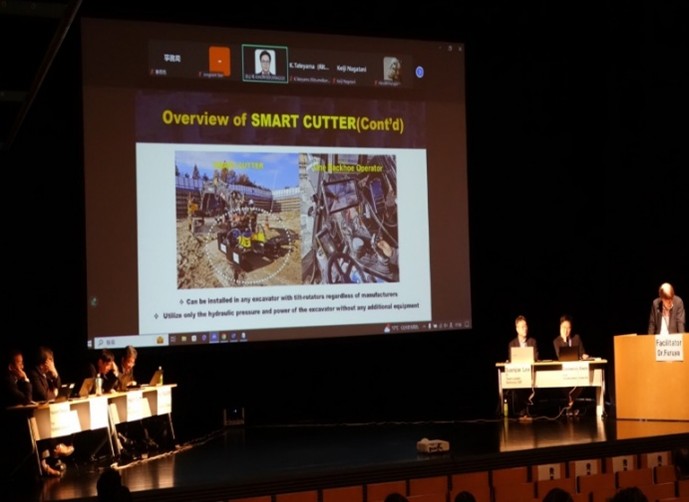
The Japan-Korea Joint Session
■ Conclusion
The 22nd Construction Robot Symposium was the first symposium to hold a Japan-Korea joint session in anticipation of future international technical exchanges.
We would like to thank the members of the Construction Robotics Research Liaison Council for their cooperation in all aspects of the symposium, from planning to management. Special thanks go to Dr. Tamura of the Center for Advanced Construction Technology and others who served as the secretariat, and to Prof. Kown and Mr. Furuya, Public Relations Committee Chairman, for their coordination of the Japan-Korea Joint Session. This joint session was supported by the Japan Society of Civil Engineers (JSCE) International Scientific Exchange Fund.
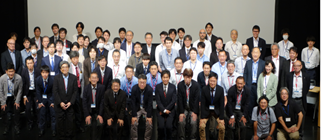
At the Venue after the Japan-Korea Joint Session
・・・・・・・・・・・・・・・・・・・・・・・・・・・・・・・・・・・・・・・・
Report by Prof. Kazuyoshi TATEYAMA
Chair, Construction Robotics Committee
・・・・・・・・・・・・・・・・・・・・・・・・・・・・・・・・・・・・・・・・・
Report on the 6th CICHE-JSCE Joint Workshop in Nagasaki
Hiromasa Iwai, IAC International Communication and
Cooperation Group Leader
(Assoc. Prof. of Kyoto University)
Overview
The 6th CICHE-JSCE Joint Workshop in Nagasaki was held from November 3 to November 5, 2024, as a three-day, two-night training camp in Sasebo City and Nagasaki City in Nagasaki Prefecture. The first joint workshop was held in Kaohsiung, Taiwan, in 2016. Since then, CICHE (Chinese Institute of Civil and Hydraulic Engineering) and JSCE have taken turns in playing host, fostering the advancement of civil engineering technologies and greater cultural exchange between the two societies. However, after the fourth workshop, which was held in Tokyo in 2019, the global impact of the COVID-19 pandemic put further workshops on hold. While we considered holding the workshop online during this time, we wanted to remain true to its essence: young researchers and civil engineers of both Taiwan and Japan “strengthening bonds face-to-face.” After 3-year pandemic halt, the workshop made a comeback thanks to the hard work of CICHE in 2023. This year, the workshop took another step forward.
Day one (November 3): consisting of an icebreaker, with a visit to Huis Ten Bosch
The first day, November 3, began with a visit to Huis Ten Bosch in Sasebo City in Nagasaki Prefecture, with this trip also acting as an icebreaker to deepen exchange between the participants. Mr. Naoki Kita of Shimizu Corporation acted as a guide, explaining the history of how Huis Ten Bosch was developed and how the civil engineering technologies of the time are still alive and well today. The attendees were captivated by the technical innovations that had brought to life this theme park built on reclaimed coastal land. For example, Huis Ten Bosch’s ability to withstand natural forces like typhoons and high waves while preserving the rich marine ecosystem and developing the waterfront. The civil engineering ingenuity behind the canal construction is fascinating. The flexibly mounted wave-breaking construction method, which achieves both typhoon and high-wave protection alongside preserving the marine ecosystem on the harsh reclaimed coastline, prompted many questions from the attendees. It was an opportunity in which witnessing the harmony between technology and nature reaffirmed the social role and potential of civil engineering.
Incorporating this kind of outdoor field work into day one was extremely effective. The participants, meeting each other for the first time, opened up organically, and it proved to be good preparation for the lectures and group discussions the next day.
Day two (November 4): focusing on lectures by the lecturing team of both societies and group discussions
On the second day, November 4, the workshop moved to Nagasaki City, where lecture sessions took place. The lecturing team, selected from members of CICHE and JSCE, gave lectures on three topics. The attendees took on board the latest knowledge and issues surrounding civil engineering. Details of the three sessions and the lecturers who took part are shown in the table below.
■ Lecture #1:Concrete on Civil Engineering, Life-cycle Performance Assessment
(CICHE) Prof. Chien-Kuo CHIU, National Taiwan University of Science and Technology
(JSCE) Assoc. Prof. Kenji SASAKI, Nagasaki University
■ Lecture #2:Structural Mechanics and Design
(CICHE) Prof. Yuan-Lung LO, National Taipei University of Technology
(JSCE) Assoc. Prof. Takafumi NISHIKAWA, Nagasaki University
■ Lecture #3:Climate Change and Environmental Issues
(CICHE) Prof. Ying-Chieh CHAN, National Taiwan University
(JSCE) Assoc. Prof. Sunhee SUK, Nagasaki University
Homework was given out at the end of each lecture, and attendees split up into three groups where they engaged in simple discussions about the set issue. With that, the academic part of day two came to a close. Everyone had dinner together on this day. With all the attendees having gotten to know each other during the site visit the day before, lively conversations filled the air and people were all smiles. It was a moment in which you could feel that “connection between people” that we had been aiming for, with peers from different cultures and backgrounds engaging in dialogue and collaborating through a shared academic discipline.
Day three (November 5): collaborative results and future challenges
On November 5, the final day, each group engaged in fully fledged discussions based on the homework from the previous day. The groups then presented their results. Based on the lecture content and debates from the day before, each group pulled together their knowledge and ideas and brainstormed within the limited time they had. What was interesting was that each group had a different vibe. One group had a relaxed atmosphere, another engaged in structured discussions, while another saw heated debates. It was impressive how the groups, each with their own style, reached a conclusion on the task within the time constraints while respecting each other’s opinions.
For the presentations, the groups used large poster paper to share the discussion process and results with everyone. Feedback from the lecturers was both kind and pinpoint. The attendees appeared to listen closely to what was said, furthering their learning. While they were, perhaps, not able to fully discuss everything due to the time constraints, this is a point to improve on for the subsequent workshops.
Summary: beyond connections and challenges
The 6th CICHE-JSCE Joint Workshop broke away significantly from the research presentation format that had been used to date, instead attempting a new challenge in the form of a seminar-based training camp. As a result, not only was knowledge shared through the lectures and the site visit, but the participants were deeply engaged with each other, thinking and collaborating throughout. I can proudly say that the participants deepened their bonds with one another through the group work and daily interactions. Aside from the civil engineering and research-related networking, the connections made between each person were the biggest success of this workshop. Youngsters of different nationalities and backgrounds used civil engineering to overcome language and cultural barriers, taking a step towards a better future. It is our responsibility to leverage this experience to make an even better workshop next time around. The 6th CICHE-JSCE Joint Workshop of “a new future through ongoing connection and challenge” was, without doubt, a step in the right direction.
Acknowledgements
I would like to say a big thank you for all the hard work of the faculty at Nagasaki University in holding this workshop in Nagasaki Prefecture. Assoc. Prof. Kenji Sasaki, Assoc. Prof. Takafumi Nishikawa, and Assoc. Prof. Sunhee Suk, who acted as lecturers on behalf of JSCE, all made time in their busy schedules to prepare lecture materials and set tasks. I also want to say thank you to them for watching over the participants’ discussions and actively giving advice with the limited time they had on the day. Also, Distinguished Professor Akihide Tada made a major contribution from preparing the workshop right through to running the events each day. Thanks to the help of the faculty staff on site, the workshop went without a hitch for everyone, including the participants from CICHE. Thank you so much.
I would also like to offer my heartfelt gratitude to Mr. Naoki Kita of Shimizu Corporation, who acted as a guide during the site visit of Huis Ten Bosch on the first day. Through Mr. Kita’s explanations, we learned how Huis Ten Bosch has met harsh natural conditions head on to achieve the perfect balance between civil engineering and environmental conservation. Thanks to Mr. Kita’s thorough commentary and on-the-ground perspective, this site visit went beyond a simple observation to become an opportunity to think about how civil engineering can exist in harmony with society and the environment.
I would also like to say a warm thank you to Dr. Makoto Kimura, Director of the International Activities Center, who watched over the workshop from day one until the final day, despite his very busy schedule. He expressed his anticipation for the workshop even in the preparation stage. Although we planned a format that was significantly different from the previous workshops, it boosted our motivation to take on a new challenge for the first time. Thank you very much!
Lastly, my sincere thanks to the JSCE International Scientific Exchange Fund (ISEF). With support from the ISEF from the very start of this project, we have continued to expand our network with CICHE and carry out further technological exchange.
・・・・・・・・・・・・・・・・・・・・・・・・・・・・・・・・・・・・・・・・
Report by: Hiromasa Iwai, IAC International Communication and Cooperation Group Leader
(Assoc. Prof. of Kyoto University)
・・・・・・・・・・・・・・・・・・・・・・・・・・・・・・・・・・・・・・・・・
■Reader Survey & Feedback Request
We would greatly appreciate your thoughts and feedback on this publication
~~~~~~~~~~~~~~~~~~~~~~~~~~~
Survey Form▶ https://forms.gle/3AVxpF8nPBK27Xpv8
~~~~~~~~~~~~~~~~~~~~~~~~~~~
Updates
■Upcoming Events
♦ JSCE Annual Meeting
Date: Monday, September 8 – Friday, September 12, 2025
Venues: Kumamoto University Kurokami Campus and Kumamoto-Jo Hall (Special Lecture, IAC Special Discussion, Plenary Discussion, Annual Paper-Reading Sessions, Networking Event)
Participation Fee: Required
▶ Details: https://committees.jsce.or.jp/zenkoku/
♦ 2025 Workshop for Global Civil Engineers
Date: Wednesday, September 10, 2025
Venue: Kumamoto Castle Hall, Conference Room A1
Participation Fee: Free (Capacity limited)
▶ Details: https://www.jsce-int.org/node/914
♦ CECAR10
Date: Tuesday, October 21 – Friday, October 24, 2025
Venue: Jeju International Convention Center, Korea
Participation Fee: Required
▶ Details: https://www.cecar10.org/
The deadline of abstract submission extended: February 3, 2025
♦ Concrete Committee Newsletter No. 74 (July 2025)
▶ https://www.jsce.or.jp/committee/concrete/e/newsletter/newsletter74/
index.html
Subscription
The IAC News is one of the communication tools to share information and ideas with the members. We would like to invite you, your friends and colleagues to join the communication and to subscribe the IAC News. Please register online: (http://www.jsce-int.org/node/150). We look forward to meeting you.

